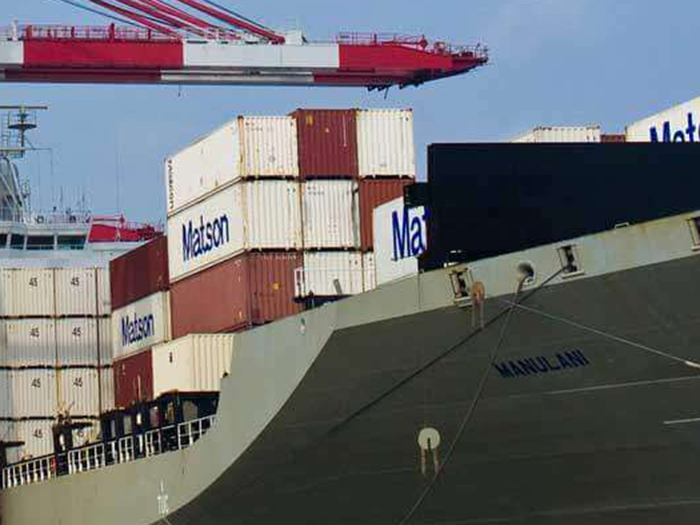
Matson to retrofit six more ships with scrubbers
Written by Nick Blenkey
Matson ship loading containers
Matson, Inc. (NYSE: MATX) has begun the installation of exhaust gas scrubbers on six vessels deployed in its Hawaii and China-Long Beach Express services as part of its strategy to comply with the IMO 2020 sulfur cap. Three of the vessels will receive the new equipment in 2019 and the remaining three in 2020.
Matson says that while new low-sulfur fuels designed to meet the new IMO emission standard have been in development for years in anticipation of the change, there is still uncertainty about their costs and availability. Although liquefied natural gas (LNG) is an alternative, the company says the infrastructure for production and distribution remains insufficient to support its operations in the Pacific.
“Because of unpredictability in the way fuel markets may develop over the next few years, Matson’s IMO compliance strategy retains the flexibility to implement the most economical solution as conditions evolve,” said John Lauer, senior vice president and chief commercial officer.
As part of its IMO 2020 strategy, Matson embarked on a fleet renewal program, replacing older vessels with four new ships that are equipped with dual-fuel engines designed to run on new low-sulfur fuels or LNG.
The other main component of Matson’s strategy involves expanded use of exhaust gas cleaning systems. It installed scrubber systems on three vessels in its Alaska fleet in 2015 and 2016, and says the success of that project became the foundation of its IMO 2020 compliance strategy.
Like the systems deployed in Alaska, the scrubber technology being installed in the six additional vessels will reduce sulfur oxides (SOx) emissions to levels at or below the limits set by the new IMO regulations and, says Matson, below those of vessels using low-sulfur fuel.
WET SCRUBBERS
At the time the scrubbers were installed in its Alaska ships, Matson noted that the hybrid “wet scrubber” exhaust gas cleaning (EGC) technology used was “unlike any other on a U.S.-flagged vessel” and that when operating within 12 miles of the coastline, it uses a closed loop system that sprays fresh water treated with sodium hydroxide into the vessel’s exhaust system and then collects and treats the wash water to neutralize harmful compounds. Consistent with Matson’s zero-solid-waste policy, the wash water is then off-loaded in port for disposal in accordance with strict environmental standards.
With the deployment of dual-fuel engines in new ships and scrubbers in additional vessels, Matson says that it will be able to meet or exceed the IMO 2020 emission standard while mitigating the expected higher cost of low-sulfur fuel over more than half of its current fleet.




